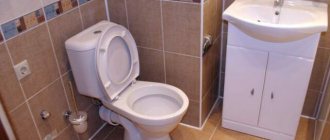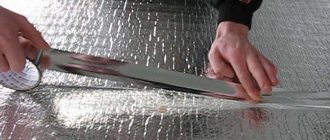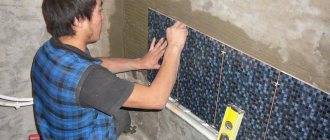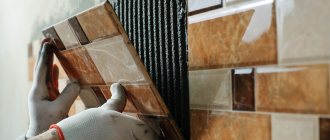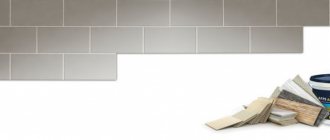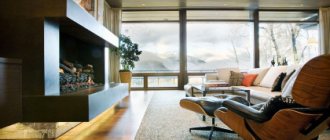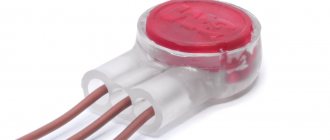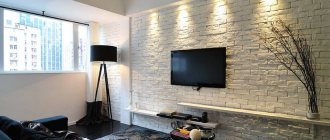Linoleum is a relatively inexpensive and easy-to-install floor covering. But it does not always tolerate heating well. Therefore, when choosing a warm floor for linoleum, you need to focus on a number of factors. It’s worth familiarizing yourself with these guidelines, don’t you agree?
We will tell you which version of the floor heating system is best to choose for installation under a laminate flooring. Here you will learn how to install it, what technological rules should be followed during assembly. Taking into account our recommendations, you can arrange a comfortable space for living with your own hands.
Why IR film is the best heated floor for linoleum
Warm floors are divided into 2 groups: water and electric, one of the varieties of which is infrared film. The material received the name “film” because of its appearance. This is a two-layer polymer film in which carbon heating elements with a unique nano-structure are mounted. They emit infrared radiation, heating the surrounding surfaces.
The heating elements look like black strips 15 mm wide, connected by copper and silver contact bars. The structure is additionally protected from damage by a layer of polymer. The system has a number of advantages:
- The film operates in a temperature range favorable for linoleum, which is why IR underfloor heating is considered an excellent choice for installation under this type of coating. The optimal power for linoleum is about 150 - 230 W per square. Infrared film provides these parameters. When installing other options, there is a risk of overheating. Even if its consequences are not immediately obvious, over time they will manifest themselves as deformation, softening, and swelling.
- The film can be laid in rooms with a non-standard layout, on balconies, loggias. Its small thickness makes it possible to use it in buildings with low ceilings.
- The installation process is simple, since “wet” work on pouring the screed is not necessary. The system ensures uniform heating of the room, is perfectly amenable to automatic adjustment and can be integrated into a “smart home” type system.
- IR heated floors have a long service life. Most manufacturers guarantee effective performance for 15 to 20 years.
A significant positive point is the easy dismantling of the system. If necessary, it is enough to remove the floor covering and lay the film on a new base or in another room. Electricity consumption when using film systems is 30% less than when using an electric heating cable over a similar area.
Features of laying linoleum
You will also need to prepare a base for the linoleum. First, a layer of polyethylene is laid on top of the infrared film. This material performs waterproofing functions.
Separate strips are laid with an overlap of 10-20 cm and secured with tape. In this case, you need to move along the surface of the infrared film very carefully so as not to damage the integrity of the graphite heaters.
Next, install a flat surface made of fiberboard. This material will reliably protect the heated floor and will become a suitable base for linoleum. This type of flooring is supplied rolled into rolls, so it is recommended to spread it out and leave it for several days before installation.
Before laying linoleum, it is necessary to lay it out on a flat surface of the heated floor, turn on the system and wait until the coating is leveled
In the case of heated floors, the process can be improved. Linoleum is laid on a fiberboard base without fastening, and then the infrared film is turned on. Under the influence of heat, the leveling process will proceed faster. The thermostat should be set to 28 degrees or slightly less. For linoleum, this temperature is considered optimal.
After the coating becomes sufficiently smooth, all that remains is to secure the linoleum to the base. This operation is performed using double-sided tape or glue.
The use of an adhesive composition is considered more suitable for use with heated floors if dismantling and relocation of the equipment is not planned. The adhesive ensures a tight fit and uniform heating.
You will learn about the specifics of installing floor heating systems on a wooden base and on a concrete floor by reading the articles we recommend.
Disadvantages of IR heated floors
It’s difficult to connect the system with your own hands without basic skills.
The system has relatively few disadvantages:
- After laying the film, you cannot rearrange the room. Bulky furniture and household appliances should not be installed at the locations of the heating surfaces - this can lead to overheating of the film and its failure.
- It is difficult to install and connect the system with your own hands without basic skills. It is not always possible for a non-professional to connect the contact to the film. It has to be cut off and connected to another contact.
- Laying a heated floor under linoleum on a concrete floor with defects leads to its deformation. Therefore, sometimes a new screed is still necessary.
- The need to install thermostats in every room.
- If infrared heating is used as an auxiliary heating system, the air humidity level in the room may be too low.
Conclusions and useful video on the topic
This video demonstrates in detail and clearly the process of laying an infrared floor:
Film heated floors are an excellent choice for laying under linoleum. Installation of such systems does not seem too complicated, but it is deceptively simple.
When laying infrared film, you must strictly adhere to the work technology and strictly follow the manufacturer’s recommendations. This will allow you to avoid mistakes and install the system correctly to ensure a long service life.
Would you like to talk about how you built a floor heating system with your own hands? Would you like to share information that will be useful to site visitors? Please write comments in the block below, post photos related to the topic of the article, and ask questions.
Criteria for choosing linoleum for film flooring
The issue of choosing linoleum for laying on a warm floor must be approached with all responsibility. Materials that do not meet the requirements react poorly to heat: they deform and release harmful substances.
The following types cannot be used in tandem with IR film flooring:
alkyd or glypthal
nitrocellulose(colloxylin)
rubber (relin)
To achieve optimal room heating results and not cause harm to health, choose vinyl (PVC) or natural (marmoleum) linoleum. These materials have important characteristics:
PVC linoleum.
Not dangerous, suitable for residential premises. When purchasing, read the labeling of the material: there should be a mark on the packaging that the coating is intended for installation on underfloor heating systems. Regular linoleum can be equipped with an additional layer of heat-insulating material, which is completely unnecessary over a heated floor. This option is not worth purchasing.
Marmoleum (natural linoleum).
The best option for installing heated floors. The material contains only natural ingredients. When heated, this linoleum releases harmful substances, does not change color over time, and effectively resists fire. Marmoleum has the only drawback - its high price. But its wear resistance and safety completely justify the costs.
Marmoleum is sensitive to strong heat, so the issue of choosing a temperature regime for such a coating must be approached very responsibly. However, this is also true for PVC materials.
Design and calculations
Installation of any infrared heated floor under linoleum requires the installation of a protective layer 3-5 mm thick made of plywood, gypsum fiber board, hardboard or fiberboard sheets. This type of floor heating and linoleum covering is usually used in the arrangement of kitchens, corridors, staircases intended for a winter garden, and other similar premises.
First you need to designate the configuration and area of those areas of the floor where the equipment and covering will be installed. The cake of a heated floor system under linoleum includes five required layers:
- Heat-reflecting substrate (Izolon, Infralex). It is allowed to use thermal insulation with a lavsan or polypropylene metallized outer layer. Laying aluminum foil materials under the IR floor is strictly prohibited.
- Infrared film floor. The equipment includes rolls with longitudinal panels with carbon stripe coating, as well as at least one temperature sensor and thermostat. The panels are connected to electricity in parallel using the terminals and wires included in the kit.
- Polyethylene. Sheets of film with a maximum thickness of 2 mm are placed on top of the IR heating system after it has been assembled and tested. Polyethylene protects the film floor from moisture and water, serving as a waterproofing agent.
- Protective hard layer. Sheets of hardboard, plywood or other similar material are laid on top of the polyethylene. This measure makes the coating more stable and hard.
- Linoleum. Secured with mastic. Only brands that are compatible with electric floor heating are suitable.
When designing the system, it is necessary to take into account that film heated floors should not be laid under large household appliances or furniture on low legs or without them at all, since they absorb a large amount of heat without radiating it. In addition, household appliances may fail due to overheating. In this case, an insulating substrate and a rigid layer are installed on the entire surface of the floor so that its height is the same.
Keep in mind that if there is a floor inside, then the IR sheet should be at a distance of 5 cm from it. It is also worth maintaining a distance of at least 20 cm between the infrared film and heat sources (fireplace, oven, pipes).
Tools and materials
Set of infrared film heated floors
To install a warm infrared floor under linoleum you need to prepare:
- heating set: infrared sheet, insulator, contact clamps;
- temperature sensor and thermostat, hollow corrugated tube;
- wiring;
- double sided tape;
- polyethylene film;
- plywood sheets;
- heat-reflecting substrate;
- nails;
- knife, scissors;
- pliers, pliers;
- screwdriver;
- tools for wall chipping.
To fix the material, you can use a construction stapler or furniture nails. if you plan a large number of small pieces of film (up to 1 m), purchase additional terminals.
Marking the room and preparing the base
The film must be placed along the entire length of the room
Before installation begins, sketch out the floor plan of the room and mark the places where stationary pieces of furniture or large household appliances that fit tightly to the floor will be installed. It is not advisable to install infrared film in these areas. When planning, consider the following points:
- The film must be placed along the entire length of the room. This will avoid a large number of connection points for installation wires.
- If electrical wiring runs inside the floor, it should be at a distance of approximately 50 mm from the IR film and insulated from the floor or wiring with heat-insulating material.
- There must be a distance of at least 200 mm between heat sources (pipes, ovens, fireplace) and the film.
- The base for infrared heated floors must be clean and level. Often it is enough to make minor surface repairs. But if there are significant irregularities, pouring a fresh concrete screed is necessary.
- A layer of thermal insulation material is placed on the prepared base. If it is a rolled material, the strips are laid end-to-end and the joints are secured with tape. The insulation should lie very evenly.
Open the films
The film is cut along the lines along the heating strips every 250 mm
After drawing up a plan for laying the film, they begin to prepare it. The procedure is as follows:
- The film is cut along lines along the heating strips every 250 mm. Cutting along any other path is prohibited! Otherwise, the warm floor will not work.
- Contact clamps are installed on the finished heating elements. In places where current-carrying copper strips and a two-layer film pass, the tip of the wire is installed on the contact strip inside the thermal film. Then a grommet is inserted into the hole and riveted with a special stapler or hammer.
- The cutting lines of the contact strip are insulated on both sides with a waterproofing strip. Protected copper wires with a cross section of 1.5 square meters. mm is brought to the tip and clamped with pliers. After this, the junction of the copper busbar and the electrical wire with the tip is insulated on both sides with a waterproofing strip.
IR film can be laid lengthwise or across the room. Optimal placement of stripes longitudinally. In this case, the number of connection points will be minimal.
Laying and connecting the film
Parts of the heating film are connected in parallel to each other
After cutting the film, install thermal insulation with a reflective layer and secure it with tape. Heating elements are laid down on the thermal insulation with copper strips. They should be positioned so as to avoid the contact of adjacent strips touching! Rules and installation procedure:
- The heating elements are secured with tape, a stapler or furniture nails. This will minimize the likelihood of the strips moving during installation of the coating. The heating elements should be attached through the transparent rim located on the sides of the element.
- The heating element must be located 5 mm from any supply section of the element, which includes copper electrical bars. The wires are positioned so that the main ones are under the baseboard. In places where the contact strips are insulated and thickening of the system is observed, cutouts are made in the thermal insulation to level the surface for the final coating.
- Parts of the heating film are connected in parallel to each other. The highest total power of the heating elements that are connected to the thermostat should not exceed 3500 W. When connecting the heating system, you should definitely take into account the presence of other electrical appliances that will be connected to this network.
- If the total power of the heating system is more than 3500 W, it is advisable to make the connection using separate electrical wiring, protected by a separate circuit breaker. Heating devices should be connected using a magnetic starter.
- After installation, you need to inspect the system, check the reliability of the insulation and fastening of the wires. Then you need to measure the resistance of the heating strips. If there are sources of possible system short circuit, they should be eliminated and the performance test repeated.
- A temperature sensor is attached with tape under the cutting line, where there is no heated section of the film. It is placed under the film and connected to the thermostat with wires. Heating elements and a sensor are attached to the thermostat.
- The thermostat itself is hung on the wall in an easily accessible place. Its connection must be made in accordance with the diagram. Those inexperienced with electricity should consult a professional. Thermal sensors Then you need to turn on the thermostat and leave it for a few minutes.
- To hide the cable leading from the thermostat, you can make a groove in the wall. If the repair has already been completed, the cable is placed on top of the wall and covered with a decorative plastic box. Below, a plinth is used to disguise the cable. The edges of the cable providing power are connected using connectors and pressed with pliers.
- The final test is to check the degree of heating of the film. Place your hand against the heating element: the warm floor under the linoleum should generate heat at a pleasant temperature.
- Finally, the infrared film is covered with a vapor barrier material, and the joints are secured with tape.
Sheets of fiberboard or plywood are laid on the vapor barrier. They are fastened with screws through a transparent rim located along the cut lines of the IR film and the sides of the element. The element should not be attached closer than 5 mm from the supply areas of the elements. The finished heated floor is covered with linoleum.
Step-by-step installation instructions
Once the type of linoleum has been selected, you can begin the process of laying the heated floor. To do this, you will need thermal film (the specific amount will be known after taking the dimensions) with all additional elements, a thermostat to control heating modes, any heat-reflecting material, ordinary plastic film, tape, a stapler, a mounting knife, scissors, pliers and a screwdriver.
Film heated floor set
Choosing a heated floor kit
Step 1. Preparing the base. If the floor is placed on concrete floors, then the surface needs to be leveled. To do this, it is better to make the screed with a cement-sand mortar; there should be no protrusions on the surface of more than 3 mm.
Floor leveling screed
Waterproofing should be placed on a completely dry screed (you can use ordinary film or coat the base with modified bitumen mastics), and sheets of OSB or plywood should be laid on top. It is recommended to fasten to a concrete base with dowels in a checkerboard pattern.
Laying plywood on the floor
Laying plywood in a checkerboard pattern
Step 2. Take measurements and draw up a diagram of the location of the thermal film. In this case, the features of the room layout and the placement of sockets or electrical cable distribution boxes are taken into account.
Infrared film installation plan
Important. When installing a heated floor, the electrical wiring capabilities of the room must be taken into account. Heated floors consume approximately 200 W per square meter of room, exact data is available in the instructions supplied by the manufacturer. The overall load on electrical networks increases significantly; it is necessary to ensure that cables and protection fittings can withstand this increase. If the heating power is more than 3 kW, then you need to make separate power wiring.
If not, then you will have to resolve issues with electricians, sometimes you will need to replace wiring and protective devices, and permission from the owners of electrical networks to increase power.
Laying the IR film system
Step 3. Select a place on the wall where you plan to install the thermostat. It must be accessible, the distance to the power source is minimal. The most optimal is considered to be a site near existing switches or sockets.
Choose a location for the thermostat on the wall
To improve thermal insulation and reduce unproductive losses, a thermal insulator with reflective aluminum foil is placed on the base of the floor under the thermal film.
Laying foil insulation
The thickness ranges from 5–6 mm; ready-made rolls with excellent performance characteristics are available. The thermal insulator can be fixed with double-sided tape or staples using a stapler. The joints between the strips must be sealed with tape, the surface must be as airtight as possible.
Installation joints or accidental cuts in the panels are glued with self-adhesive aluminum tape
Step 4. Place the thermal film, while paying attention to the markings, the bottom side should be facing the heat-reflecting film.
The photo shows an unfolded IR film
Practical advice. It is recommended not to heat under low furniture for two reasons. Firstly, it is ineffective due to weak air convection. Secondly, elevated temperatures cause premature wear of furniture, it dries out, and factory settings are violated.
In the designated areas, the thermal film is cut to the required size.
Cutting IR films
Step 5. Connection and isolation. All work should be carried out in unconditional compliance with the requirements of the PUE and the manufacturer’s recommendations. The heated floor is equipped with a full set of connectors and special insulating materials; their use guarantees long-term and safe operation of the structure. The cut areas of the wide copper bus are insulated with special bitumen insulation; make sure that it fits over the entire area of the conductive element. In the places where the wires will be connected to the copper bus, contact clamps are installed, one side of them should be located inside and the other outside the thermal film. The clamps are squeezed tightly with pliers.
Attaching the contact clip to the thermal film
Attaching the contact clip to the thermal film
Contact clip mounted on thermal film (bottom view)
An example of the correct installation of insulation on a copper busbar cutting line
Completion of the process of insulating the copper busbar cutting line
Step 6. All strips of thermal film should be secured together with tape to eliminate the possibility of shifting. Next, check the correct installation of the clamps and film; if everything is fine, then you can connect the power wires.
Connection of installation wires with a contact clamp Connection of installation wires with a contact clamp
To increase service life, it is advisable to tin the bare ends. This not only improves contact at the joints and prevents oxidation processes, but also increases the safety of using heated floors. If there is insufficient contact, the clamps become very hot and can melt the linoleum. Leg burns, electric shock or fire may occur. All terminals with connected wires must be insulated with a special bitumen film on both sides. Make sure that the silver contacts of the thermal film are completely insulated at the bottom and top.
Clamp the wires securely into the terminal clamp
Example of correct installation of the bottom insulation sheet for contact terminals
Installing the top insulation sheet
View of an insulated contact clamp with wires connected
Step 7. You can begin connecting the thermostat only after carefully reading the attached instructions. The heating temperature sensor is mounted on a black strip of thermal film and secured with insulating tape. There are cases when it is installed above the floor and reacts to the air temperature inside the room.
Installing a floor temperature sensor
The sensor is attached to the thermal film with bitumen insulation
installed and glued floor temperature sensor. Bottom view of thermal film
Installed and glued floor temperature sensor. Top view of thermal film
Step 8. Use a mounting knife to make recesses in the thermal insulation for all the clamps and sensor. The protruding parts of the elements will be hidden in these recesses, the floor will be flat, and there will be no technological elevations on the linoleum. The same grooves are made for the wires so that they lie in the designated places and are fixed on top with tape.
Step 9. Install the thermostat on the wall. To do this, you need to remove the mounting panel and make markings for the installation locations of the dowels. The holes are drilled using a drill with pobedite surfacing. The case must be firmly fixed, do not allow it to wobble.
Choosing an installation location
Installation of a thermostat for film heated floors
Mechanical thermostat
Installing a thermostat
Video - How to connect the regulator to a heated floor
Practical advice. When drilling holes in a brick wall, there are times when the drill gets into a seam. In this place, the fixation strength of the dowel is insufficient; it wobbles and is easily pulled out. To securely fasten, insert matches or toothpicks into the hole around the perimeter; they should press the dowel tightly on all sides. After driving the dowel-nail, the connection will be very reliable.
Step 10. According to the connection diagram, attach the wires to the thermostat and connect the system to the electrical network. If the heating power is more than 2 kW, then be sure to install a separate automatic machine.
At this point, the installation work is completed, you can begin testing the floor heating system.
Possible mistakes
The film floor should be heated evenly. If there is no heat or some areas are colder or hotter than others, it means the installation was done incorrectly. Possible errors should be found and eliminated. Problems usually arise with the following violations:
- Laying film strips overlapping. This position of the heating material is unacceptable.
- Cutting the film too close to the copper bar. This may cause insulation failure. Complete or partial lack of insulation is one of the most common causes of underfloor heating failure.
- Using mastics to fix linoleum. All these compounds are sources of harmful compounds. In addition, during uneven heating they will form swelling on the surface. Removing such defects is difficult and often impossible.
Temperature
It is important to understand that in any case, linoleum cannot be placed on overly powerful systems. Thus, the recommended floor power parameter should not exceed 150-180 W/m2. Only under such conditions will the heating temperature not exceed the permissible 27-28 degrees, which means that the linoleum will not deform and will not begin to release toxic substances into the air.
What kind of linoleum can be laid on an infrared film floor
If you neglect these parameters, there is a risk that:
- linoleum will change color;
- the material is deformed;
- phenol will be released into the air;
- delamination of the coating will occur.
Deformation of linoleum
It is important to understand that at temperatures of 27-28 degrees, floors may seem somewhat cool . But you can’t heat linoleum any higher. If the specified floor temperature does not suit the home owners, then they should abandon the idea of using linoleum as a finishing material and choose some other coating.
Questions
What happens if you install a more powerful IR heated floor than recommended (for example, 240 W sq./m)?
This will cause negative consequences. Due to more intense heating, linoleum can become vulnerable to tearing and soft, and begin to move away from the base and expand. The most dangerous thing is that in the places where the thermal film is laid, the release of harmful substances will begin in fairly large volumes.
Is it possible to connect two heated floors to one thermostat?
Can. But you need to take into account their total power: it should not exceed the power for which the regulator is designed (3-3.2 kW). It is also worth understanding that only one floor temperature sensor comes from the regulator. If the rooms differ greatly in heat loss from each other, then the same temperature will not be achieved. Therefore, this connection is recommended to be used exclusively for large areas in one room, or adjacent ones, without a door partition.
Is it possible to connect two heated floors, cable and film, to one thermostat?
It is forbidden. They have different performance characteristics that require individual adjustment.
I set the recommended temperature, but the floor is not warm enough, only +28 degrees. Maybe the film is not working properly?
The floor is working correctly. It is the temperature of + 28 degrees that guarantees the energy efficiency of the IR floor. If you select a higher temperature, the energy efficiency will become negligible. If you think that the floor is not warm enough, check its heating with your hand and you will make sure that it warms up as it should. The linoleum surface should not be hot. If you want to get hot air in your house, you should think about additional heating for the walls and ceiling. But in any case, it is the warm floor that will help you achieve the recommended indicators.
Connecting the electrical system
For everything to work well and correctly, you need to connect everything correctly and select the optimal wire cross-section. The connection diagram can be one-sided or two-sided depending on the location of the power wire. The wire cross-section is suitable 1.5-2.5 mm. If the film consumption is more than 2-3 kW, then it will be necessary to run a separate electrical wiring line, and this already smells like replacing electrical wiring. Below are connection diagrams, from which I think everything will become clear to you. Connecting the thermostat should not be difficult, since each one comes with connection instructions.
connection diagram for 2 sides
connection diagram for 1 side
This concludes this article; I think it was useful to you. If anything is unclear or you disagree with something, please leave your opinion in the comments. Thank you for your attention, see you soon on the blog.
Preparing a Wooden Floor
However, despite all the nuances, it is quite possible to install heated floors made of wood with linoleum finishing. First of all, you should take care of preparing the wooden base itself for further work.
First, it’s worth assessing the condition of the wooden floor. It should be smooth and durable, the boards should not “walk”. All rotten and damaged boards should be replaced with new ones, and all cracks and gaps should be eliminated. If you neglect to seal the cracks, the heat will partially go under the floor and be lost, which means that the energy consumption for heating the base will increase. The nail heads need to be recessed into the wooden base so that they do not stick out. It is recommended to fill small holes with putty.
Wooden floors need to be properly prepared
Important! Linoleum, like the infrared flooring system, should only be laid on a very level base.
If necessary, the base can be leveled by laying sheets of plywood or other material on top and securing them. It is also recommended to treat wooden floors with an antiseptic and fire-resistant compound, just in case. And the outside of the boards themselves, if necessary, are polished using special equipment.
Leveling a wooden floor with plywood
Advantages and disadvantages
The main advantages of installing underfloor heating film are:
- there is no need to install a cement screed - the floor covering is laid immediately;
- due to its small thickness, the film does not change the height of the room;
- film floors consume less electrical energy than other heating systems;
- the cost of film flooring is acceptable for many buyers;
- the finished surface is pleasant to the touch.
In addition to the positive qualities, there are also negative aspects:
- the surface for laying the film floor must be perfectly flat;
- many people make mistakes when connecting contacts, after which the film has to be cut to open the next working element;
- this type of surface does not guarantee fire safety;
- A film floor can strongly heat objects, on the surface of which dark spots appear over time.
What does a film heated floor look like?
Types of substrates
To insulate the floor under linoleum, you first need to select a substrate. There are several types of such material. Here are the most popular:
- cork;
- jute;
- linen
Let's look at each separately.
Cork backing is made from compressed crushed cork oak bark. This insulation is produced in rolls. The advantages of this material include:
- environmental friendliness - made from natural cork;
- There is a pleasant feeling when walking on this surface, as it is quite soft.
It is precisely because of the last positive quality mentioned that a problem may arise: if you place a heavy object on the coating, then after some time dents may form on it. To avoid this, you should choose the hardest cork backing.
Jute backing is a material consisting of 100% natural jute fiber. It is made as follows: jute fibers are punched with a needle, then rolled on rollers under high temperature. This substrate is fire resistant, resistant to mold and rot.
Linen backing is 100% pure natural linen. It is made by double-piercing with a needle and then impregnated with anti-fire and anti-fungal agents. Linen backing is a good material for thermal insulation under linoleum.
Concrete floor installation
You can immediately solve the problems associated with installing the “Warm Floor” system on a concrete base and choose the appropriate type of linoleum when the subfloor already exists. If instead there is only an old rotten wooden base or just soil, you need to start constructing the concrete floor itself.
The process consists of several stages:
- dismantling the old floor, if any;
- leveling the base;
- pillow devices;
- arrangement of an insulating layer;
- preparing and pouring concrete mortar.
Leveling the soil is done using a shovel. Then they begin to create a pillow. To do this, crushed stone or small pieces of brick and broken slate are poured to a height of about 50 mm. All this is lightly compacted.
The perimeter of the room is covered with sheet foam having a thickness of 20 - 50 mm. It will serve as formwork and at the same time balance the thermal expansion of the concrete base. Clean sand is poured onto this layer - 10 centimeters.
Next comes the installation of the second type of insulation. Extruded polystyrene foam is most suitable for this, preferably the Penoplex brand, which is produced in the form of rigid slabs with a thickness of at least 50 mm.
Expanded polystyrene or penoplex is resistant to temperature changes, environmentally friendly, tolerates compression loads well, moisture resistant, durable
The manufacturer has provided a locking connection on the sheets, so there are no gaps left when laying them. During installation, you need to ensure the horizontal position using a level. Waterproofing is not needed here, because... the material is extremely moisture resistant.
The next stage is preparing the solution. The optimal ratio of components is 1 part cement, twice as much sand and three times as much screenings. As a result, the solution should not be fluid, but not excessively thick.
In order not to heavily load the floor, light fillers and levelers are introduced into the concrete solution. Before pouring the solution, place beacons near the walls and stretch a cord between them. Using these marks as a guide, intermediate marker strips are placed.
A cement base of a traditional composition with a height of 10 mm weighs about 20 kg, so it can only be used when a heated floor is installed on the ground floor of a house or when there is a very durable floor underneath it
The surface is moistened and the solution is placed on it between the beacons and leveled with the rule. As it sets, the surface is leveled. At the end, apply a building level to check the horizontalness. Afterwards, the marks are removed, the resulting voids are filled with solution and everything is left until completely dry.
Features of a wooden base
The ideal base for installing a heating system is concrete. It has optimal thermal conductivity and is ideal for laying heated floors. In addition, it is able to retain heat, which means it will save energy on heating.
Wooden floor
But in some cases, heating systems are installed on a wooden floor. In such a situation, the following advantages can be noted:
- no need to install a heavy cement screed;
- there is no need to dismantle old floors, provided that they are level and in good condition;
- you can reduce the time spent on work;
- there is no need to wait a certain time - the floors can be used immediately;
- additional loads on the floors are eliminated;
- the floor pie will remain almost unchanged in height.
A wooden base has its pros and cons
But even if all these factors are taken into account, one cannot help but think that a wooden floor has worse thermal conductivity than a concrete one. This means that it will heat up worse. Moreover, not every heating system can be installed on wooden floors, especially if they are old enough and require repair. In the latter case, the easiest way is to dismantle them and lay the heating directly on the concrete.
Also, on a wooden floor it will not be possible to build even a thin cement screed, which is almost always necessary when installing a water or electric cable floor. This is precisely what complicates the possibility of installing a heating system on a wooden base.
Wooden floors are not the best option for heated floors
Cable electric floor
When laying a cable system, the concrete floor is first leveled, then a reinforcing mesh or special fastening tape is laid on it. The cable is placed on it, fixed, and then filled with concrete mixture. When the screed is dry, lay linoleum.
Before all this work, determine the length of the cable. If it is placed in 15 cm increments, one loop will take approximately 25 cm.
Given the known area of the room in which the heated floor is to be installed, calculate the number of turns, cable branches and its overall length. To the resulting value is added the segment running from the screed to the wall where the thermostat is located.
When calculating the area covered by a heated floor, the mandatory five-centimeter distance from the walls and the space occupied by furniture are subtracted from its total value. On a clean concrete floor, thermal insulation is applied over its entire area. Tape the joints with foil tape.
In the area reserved for the installation of heated floors, a metal tape is laid to secure the cable so that it is enough to cover the entire area. There is a place on the wall for the regulator. Then a hole is made for installing the mounting box and grooves are laid. After installing the regulator, a temperature sensor is attached to it.
The wire coming from the heating elements is laid to the temperature regulator. A temperature sensor mounted in a corrugated pipe and a cable from the main power supply are also brought here
The heating cable is laid starting from the edge of the corrugated tube, on which the cable end sleeve should be present. The electric floor is assembled by adhering to the calculated step in the form of a snake; the branches are laid evenly, excluding creases at turns. Fix the heating cable with hooks located on the previously laid metal tape.
You shouldn’t pull it too hard, but the cable should still be as straight as possible. The pitch is calculated by multiplying the heated area by 100 and then dividing the result by the length of the cable.
After briefly testing the system, a 5-centimeter layer of screed is poured. When it dries, install the finishing coat.
Water floor covering
The water heating system goes well with the concrete base. But the final covering made of linoleum is not the best choice in this case. Still, a certain type of linoleum can be laid. The main thing is that it is not thick and of low quality.
The scheme should be thought out in advance. A waterproofing layer is laid on a pre-prepared base. Strips of tape are glued along the joints between the strips. Slab thermal insulation is placed on top, which is secured with special fasteners - “fungi”, for which holes are pre-drilled.
In the collector, the temperature of the water entering the system decreases, because Here the heated coolant is mixed with the cold one. In addition, this device is responsible for adjusting the volume of coolant supplied separately to each circuit
Using the same “fungi”, a reinforcing mesh is attached to the insulation, making an overlap, the size of one cell, and using plastic clamps to connect the individual strips. A manifold is installed on the wall, and pipes are subsequently connected to it. Thermal expansion of the floor is compensated by gluing a special tape to the walls surrounding it.
After this, you can attach the pipes that form the heating circuit to the reinforcing mesh, and then connect them to the collector. A more advanced way of fixing underfloor heating pipes is to use a specially designed mounting system with click clamps or guide clips. It is fixed to the concrete base before the pipes are laid.
This system of fastening the tubes guarantees precise pitch adjustment and reliable fastening that prevents them from moving during pouring of the screed and its hardening.
To start pouring screed on a water floor, the pipes need to be filled with water, and beacons must be installed on the floor and leveled with a laser level. A screed with a minimum thickness of 40 mm is poured according to the same rules as for installing other types of heated floors.
It will be possible to decorate the floor with linoleum no earlier than in a month. During this time, the cement screed will gain the necessary strength. Until this moment, the water heated floor cannot be put into operation.
The technology for constructing a heating system for linoleum on a wooden base will be introduced in the following article, which thoroughly examines the rules and features of such a system.
Heating system testing
To do this, set the heating indicator on the thermostat at 20 - 25 degrees and wait a few minutes. Check with your hand whether the mounted film heaters have warmed up. Then the power is turned off completely to see how the electrical connections heat up.
We recommend: 10 best stabilizers for gas boilers
Their temperature should be the same as that of the film. In the case when it is much higher, this means that the contacts are unreliable. They must be checked, and the cause of excessive heating must be identified and eliminated.
